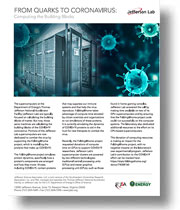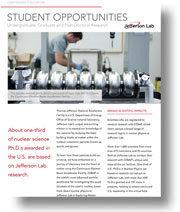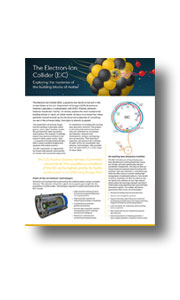JEFFERSON LAB SEARCH
-
Welcome to the Thomas Jefferson National Accelerator Facility.
Welcome to the Thomas Jefferson National Accelerator Facility.
-
Accelerator Seminar: Nicholas Sereno | October 19, 2023 | 11am | CC L102/Zoom
Title: Fast Orbit Feedback (FOFB)System Design and R&D for the APS Upgrade (APS-U)
-
Accelerator Seminar: Yaroslav Derbenev | November 2, 2023 | 11am | CC F113/Zoom
Title: To the Issue of Geodesics and Torsion in the Theory of Gravitation
Abstract:
-
A recording of the Oct 23rd 2023 Theory Seminar given by Aaron Meyer (LLNL)
A talk by Aaron Meyer
-
Jefferson Lab is home to the world's most powerful tunable Free-Electron Laser.
Jefferson Lab is home to the world's most powerful tunable Free-Electron Laser. The FEL uses the same superconducting radiofrequency technology as Jefferson Lab's CEBAF accelerator. The FEL has been used to conduct an extensive range of applied and basic research.Unique to the FEL is the range of light it can produce. This tunability allows scientists to test multiple wavelengths of light. Another innovation that makes Jefferson Lab's FEL unique is its use of the energy-recovery linac, which allows the FEL to recycle energy from its electrons.
-
The new experimental Hall D will use the electron beam to produce a coherent bremsstrahlung beam and house a solenoid detector to carry out a program in gluonic spectroscopy to experimentally test current understanding of quark confinement.
The 12 GeV Upgrade is highly cost effective due to existing features of the Continuous Electron Beam Accelerator Facility (CEBAF). The superconducting radiofrequency linear accelerators contain superconducting niobium cavities operating, on average, at 50 percent above their design specifications in accelerating gradient and Q. The success of this technology opens up the possibility of a relatively simple, inexpensive upgrade of CEBAF's top energy.
-
Hall C is 150 feet in diameter and 60 feet tall.
Hall C is 150 feet in diameter and 60 feet tall. Hall C houses a High Momentum Spectrometer and has been used extensively for large-installation experiments. These are stand-alone experiments requiring unique or highly specialized detectors, magnets and targeting systems. Experiments run in Hall C have covered a broad spectrum of topics, including the structure of pions, kaon particle production, excited states of the proton, and duality.




